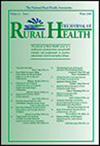An updated model of rural hospital financial distress
Abstract
Purpose
To create a model that predicts future financial distress among rural hospitals.
Methods
The sample included 14,116 yearly observations of 2311 rural hospitals recorded between 2013 and 2019. We randomly separated all sampled hospitals into a training set and test set at the start of our analysis. We used hospital financial performance, government reimbursement, organizational traits, and market characteristics to predict a given hospital's risk of experiencing one of three financial distress outcomes—negative cash flow margin, negative equity, or closure.
Findings
The model's area under the receiver operating characteristic curve (AUC) equaled 0.87 within the test set, indicating good predictive ability. We classified 30.55% of the observations in our sample as lowest risk of experiencing financial distress over the next 2 years. In comparison, we classified 32.52% of observations as mid-lowest risk of distress, 26.40% of observations as mid-highest risk, and 10.52% of observations as highest risk. Among test set observations classified as lowest-risk, 5.78% experienced negative cash flow margin within 2 years, 1.50% experienced negative equity within 2 years, and zero observations experienced closure within 2 years. Within the highest-risk group, 61.57% of observations experienced negative cash flow margin, 43.02% experienced negative equity, and 3.33% experienced closure.
Conclusions
Given the ongoing challenges and consequences of rural hospital unprofitability, there is a clear need for accurate assessments of financial distress risk. The financial distress model can be used by researchers, policymakers, and rural health advocates as a screening tool to identify at-risk rural hospitals for closer monitoring.


 求助内容:
求助内容: 应助结果提醒方式:
应助结果提醒方式:


